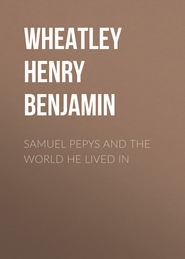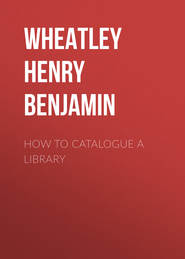По всем вопросам обращайтесь на: info@litportal.ru
(©) 2003-2024.
✖
Prices of Books
Автор
Год написания книги
2018
Настройки чтения
Размер шрифта
Высота строк
Поля
Bryant (1807), £17, 17s. Dent (1827), £14, 14s. Sykes, £16. Nassau, 15 guineas. H. Perkins (1873), £29. Comerford (1881), £41. Beresford-Hope (1882), £38. Beckford (1882), £52.
Aubrey’s Surrey, 5 vols., 1719. Large paper.
Dent, £19, 5s. H. Perkins (1873), £32, 10s.
Blomefield’s Norfolk, 5 vols., 1739-75.
Comerford (1881), £160 (illustrated). Earl of Gosford (1884), £87 (drawings by Cotman inserted). William Brice, &c. (1887), £20.
Drake’s (T.) Eboracum, History of the City of York, 1736. Large paper, proof-plates coloured, in red morocco by Kalthoeber.
H. Perkins (1873), £25. Beckford (1882), £63.
Dugdale’s (Sir W.) Antiquities of Warwickshire, 1656. First edition, and the only one admitted as evidence in a court of law.
Bindley, £10, 10s. Sykes, £11, 11s. Comerford, £12, 10s. Beckford (1882), £20. Sunderland (1882), £15.
Dugdale’s Warwickshire, 2 vols., 1730. Large paper.
Dent, £33. Sykes, £39, 8s. Heath, £64, 1s. Nassau, £33. Willett, £52, 10s. H. Perkins (1873), £84 (red morocco by Derome).
Gough’s Sepulchral Monuments, 5 vols., 1786-96.
Fonthill, £92, 8s. Beckford (1882), £31. (Same copy.)
Loggan (D.), Oxonia illustrata, 1675.
Beckford (1882), £14 (old red morocco).
–– Cantabrigia illustrata, 1688.
Beckford (1882), £11 (old red morocco).
Nichols’s Leicestershire, four vols. in eight, 1795-1815. Large paper (original edition of vol. iv., part 1), russia extra.
H. Perkins (1873) £260. Earl of Gosford (1884), £275.
Ormerod’s Cheshire, 3 vols., 1819. Large paper.
H. Perkins (1873), plates in three states-etchings, proofs, and proofs on India paper, morocco extra by Lewis, one of six copies, £155.
Plot’s Oxfordshire, 1677. Large paper.
Beckford (1883), £8, 15s. (old red morocco).
–– Staffordshire, 1686. Large paper.
Beckford (1883), £40, 10s. (old black morocco).
Thoroton’s Nottinghamshire, 1677.
Heber (part 9), £11, 5s. Beresford-Hope (1882), £11. Beckford (1883), £14, 10s.
First editions of our English classics have increased greatly in price of late years. Many of Defoe’s works are very scarce, and bring good prices. The late Mr. James Crossley had a fine collection of these, but his library was in such poor condition that the books did not sell well. The British Museum bought at his sale, June 20, 1885, the autograph manuscript of Defoe’s “Compleat English Gentleman,” which had never been printed until Mr. Nutt issued it to subscribers in 1890. The manuscript remained in the possession of Defoe’s relations, the Baker family, for more than a hundred years, as Dawson Turner bought it in 1831 from the Rev. H. D. F. Baker, the descendant of Henry Baker, son-in-law of Defoe, for £69. In 1859, at the sale of Turner’s MSS., Crossley bought the book for £75, 8s.
Robinson Crusoe, first edition, 2 vols., 1719.
Roxburghe (1812), £1, 4s. Sotheby’s (1846), £4, 16s. (with “Serious Reflections,” 3 vols., 1719-20).
Alfred Crampton, 1896 (3 vols.), £75.
Sir Cecil Domville, 1897 (part 1), £45, 10s.
Walton’s Angler, 1653, first edition.
Rev. J. Brand (1807), £3, 3s. (fine copy). Hunter (1813), £7, 10s. Utterson (1852), £11, 15s. Beckford (1883), fine copy in green morocco, £87—Bain. Gibson-Craig (1887), £195 (morocco). Gibson-Craig (1888), £23 (imperfect, sold with all faults). G. Wood (Sotheby, 1891), £310 (clean, in original sheepskin). Sotheby (December 1895), £415.
Goldsmith’s Vicar of Wakefield, 1766, first edition.
Mansfield-Mackenzie (1889), £67. T. B. T. Hildyard (1895), £56 (original calf). Alfred Crampton (1896), £65 (morocco extra by Bedford). Rare Books and MSS. (Sotheby, March 1897), £60 (original calf).
BOOKS ON VELLUM
Collectors have always had a fancy for these very choice books, and that the taste has not yet died out is seen from the fact that the late William Morris printed copies of the beautiful books issued from the Kelmscott Press on vellum, and was particularly careful in the selection of the skins, which he obtained at first from Italy. A complete set of all the books on vellum (including Chaucer), forty-nine volumes, were offered at the Kelmscott Press for £650, and have been sold at that price.
We can understand the early printed books being struck off upon vellum, as the printers appreciated that material on account of its use by the scribes in the production of the beautiful manuscripts of a former age, but it is surely infinitely more convenient to have a book printed on good paper rather than on such a refractory material as vellum. Some collectors have been so infatuated as to confine their libraries to books printed on vellum, and the French Marshal Junot was one of them. Modern books were printed for him on this substance; but when they came to be sold it was found that the public did not care much for his books, and more than half of them were bought in. One of the lots illustrates in a remarkable manner the advance in prices at the present time. The book was Longus’s Pastoralia, printed by Didot in 1802. One copy only was pulled on vellum for the Marshal, and this volume contained the original drawings of Proudhon, and a set of proof impressions of the engravings. At the Junot sale in 1816 this book only realised £37, 10s.; at the Beckford sale it brought £900. One of the most charming of Junot’s books was the Didot Horace of 1799 folio, a volume which contained the original drawings from which the copperplate vignettes were executed. This was bought by George Hibbert for £140.
Of old books, mention may be made of the dedication copy to James V. of John Bellenden’s translation of Hector Boece’s “Cronikles of Scotland” (1536), which was printed on vellum, and which, in a fine old binding, realised at the Duke of Hamilton’s sale (1884), £800.
Dibdin styled this hobby of collectors the fifth symptom of the bibliomania, and he gave a list of the vellum-printed books in Count MacCarthy’s and James Edwards’s libraries. In the latter collection was a copy of Martin Luther’s German Bible (Augsburg, 1535, two vols. folio), which sold for the reasonable price of £52, 10s. These copies on vellum were printed at the charge of John Frederick, Elector of Saxony.
Edwards employed Bodoni to print for him six copies of the edition of the “Castle of Otranto” (Parma, 1791) on vellum, and his own copy, made up with a selection of the best sheets, sold at his sale in 1815 for £29, 8s.
At Watson Taylor’s sale Pope’s “Essay on Man” (1819), printed on vellum, sold for £10.
Mention has already been made of the grand copies on vellum of the earliest productions of the printing-press—the Mazarin Bible, &c.
ILLUSTRATED BOOKS
Good illustrated books, which are an ornament to any library, are now high priced, and are not likely to fall in value. Such books as Dibdin’s bibliographical works, Rogers’s “Italy” and “Poems,” and many other books of a like kind, must always be a delight to the æsthetic collector.
Collections of engraved portraits have realised great prices, such as Holland’s Basiliωgia (1618), which sold for £600 at Christie’s in 1811; and his Herωologia (1620), which sold for £17 at the Beckford sale, £28, 10s. at the Earl of Crawford’s sale (1887), and £19, 15s. at W. H. Crawford’s (Lakelands) sale (1891); and the superb series of Vandyck’s etchings, which sold for £2850 at the Beckford sale.
Great prices have also been paid for extra illustrated books; but it is useless to record the prices given for them, unless a list of the contents is given also. Grangerising has been ridiculed with much justice, and some of the bulky works which have been produced, such as the illustrated Bibles and Shakespeares, are instances of a very absurd mania. Dr. Hill Burton gave an amusing and by no means exaggerated sketch in his “Book Hunter” of how the compiler set about his work. Now in England Grangerising is mostly confined within the limits of illustrating topographical works with views and historical books with portraits, but in the United States the old plan is said to be still in force.
BINDINGS
In no class of books have prices more conspicuously advanced than in the case of bindings, and in many sales that have taken place of late years fine specimens have been brought to the hammer; but no sale could compare with that of the Beckford library in this respect. Good examples of the libraries of Margaret of Valois, Maioli, Grolier, Thuanus, and Canevari are eagerly sought after, and the following prices of some of the choicest of these bindings will give readers an idea of the current values of these charming books:—









